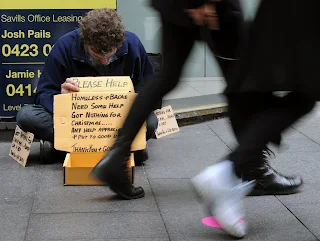The largest metropolis in any nation is bound to be special, controversial and unique. Several British colonies around the Australian coast vied for the honour and title of going to be the most important, the most productive and the most nurturing city. One may speculate about the harbour with many bays, or the more benign climate between the tropics and the temperate, but Sydney turned out to be ahead of other locations, even those with more viable hinterlands. A city may be great, but it is the people who live there - and enjoy the best of its opportunities or suffer the worst of its excesses - who count and matter. A sprawling urban congregation may thrive on the benefits of business and economic advantage, but the final judgement of a meaningful place to call home is its heart, its degree of organisation and the quality of its environs. Above image (credit to Torsten Blackwood / AP/ Getty Images) encapsulates the view of a beggar on a city street pavement, in a country with structured social security, rather high minimal salary rates and a relatively low population.
Sydney was founded more than 224 years ago, and yet it is relatively young compared to the old cultures of the world. Added to the indigenous history are the heritage richness of various streams of immigrants, most recently from both the Western and Eastern Hemispheres. Once joined to old land masses, it currently is infused with strong influences from more than two hundred nationalities. A significant contribution to what Sydney is today was made by the working classes, many of them from the Celtic tradition and arising from mass Irish immigration to the New World. Image above, Scruffy Murphy's Pub stands proudly alongside surrounding skyscraper buildings in the Chinatown district and near Central Station.
What the denizens of a great city do in their spare time also define the character and attractiveness of a place. Slim cyclists are seen out on the streets of Sydney and its suburbs on any weekend, especially early mornings (above, along Anzac Parade in Kingsford on a December morning), whether in groups, leisurely solo or on training intent. The world perceives Sydney as a surf beach mecca, and rightly so - but more than that, essentially most of its residents love the elements of the outdoors, wear shades and get the barbie going, plus not missing any opportunity to be one with Nature, whether in bush trialling, taking a drive, walking the dog, boating, having picnics or having a beer on the patio.
And of course , eating in innovative restaurants, during home parties, on outdoor pavements or in ethnic enclaves. Melbourne can claim that as well, except for the different climate. Sydney has always had notable southern Italian food, questionable American fast food and retro Chinese food. In the past twenty years, Sydneysiders have had the privilege of having access to more varieties of cuisine at various price levels than almost any other city on Earth (again, maybe except for Melbourne). Above, a typical Singaporean food joint and below, the corner of Crown and Oxford Streets, in Darlinghurst, one of the many growing hubs of choice in dining.

There is no such thing as the perfect place. For all the variety of its entertainment options, cultural displays and seaside bays, Sydney city has still to grapple with long standing issues - to improve public transport, a housing dilemma (above image - inner city apartments ), rising costs of living, traffic gridlock at rush hours, quality of personal and property security and childcare challenges. They increasingly say that if one has wealth, it is a good Sydney to live in, and if not, oh well, please just refer back to the very first picture in this piece. The spectacular fireworks at Sydney Harbour on New Year's Eve may give a thrll for a night, but it is the city's residents who has to face the reality of daily life long after that magical, annual stroke of midnight.



























